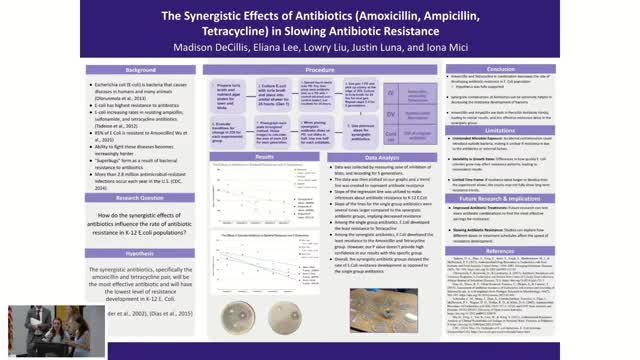Research team identifies effective antibiotic combinations to combat E. Coli resistance
June 19, 2025 | MINEOLA UNION FREE SCHOOL DISTRICT, School Districts, New York
This article was created by AI summarizing key points discussed. AI makes mistakes, so for full details and context, please refer to the video of the full meeting. Please report any errors so we can fix them. Report an error »

In a recent government meeting held in Mineola, New York, researchers presented groundbreaking findings on antibiotic resistance, a pressing public health concern. The project, titled "The Synergistic Effects of Antibiotics in Slowing Antibiotic Resistance," highlighted alarming statistics: approximately 2.8 million antimicrobial-resistant infections occur annually in the United States alone.
The researchers focused on E. coli, a common bacterium that has shown increasing resistance to antibiotics like ampicillin and amoxicillin. Their central research question explored how the combined effects of different antibiotics could influence the rate of resistance in K-12 E. coli populations. They hypothesized that a combination of tetracycline and amoxicillin would be the most effective in reducing resistance levels.
To test their hypothesis, the team meticulously prepared petri dishes with nutrient agar and cultured E. coli for 24 hours. They conducted multiple trials, comparing the effects of the antibiotic combination against control groups treated with alcohol and water. Notably, they employed a unique method for the synergistic pairs, combining two antibiotics on a single blot.
The results were telling. Data indicated a general trend of decreasing antibiotic effectiveness over generations, suggesting that bacteria were indeed gaining resistance. However, the synergistic antibiotic groups demonstrated a delayed rate of resistance development compared to those treated with single antibiotics. This finding supported their hypothesis, confirming that the combination of amoxicillin and tetracycline was particularly effective in combating resistance.
While the research yielded promising results, the team acknowledged limitations, including the potential for unintended microbial exposure due to possible contamination during the experiment. They emphasized the need for further research to explore additional antibiotic combinations that could enhance treatment effectiveness.
As the meeting concluded, the implications of this research resonated deeply. With antibiotic resistance on the rise, the findings could pave the way for improved treatment strategies, offering hope in the ongoing battle against resistant infections. The researchers left the room, their work a reminder of the critical need for innovative solutions in public health.
The researchers focused on E. coli, a common bacterium that has shown increasing resistance to antibiotics like ampicillin and amoxicillin. Their central research question explored how the combined effects of different antibiotics could influence the rate of resistance in K-12 E. coli populations. They hypothesized that a combination of tetracycline and amoxicillin would be the most effective in reducing resistance levels.
To test their hypothesis, the team meticulously prepared petri dishes with nutrient agar and cultured E. coli for 24 hours. They conducted multiple trials, comparing the effects of the antibiotic combination against control groups treated with alcohol and water. Notably, they employed a unique method for the synergistic pairs, combining two antibiotics on a single blot.
The results were telling. Data indicated a general trend of decreasing antibiotic effectiveness over generations, suggesting that bacteria were indeed gaining resistance. However, the synergistic antibiotic groups demonstrated a delayed rate of resistance development compared to those treated with single antibiotics. This finding supported their hypothesis, confirming that the combination of amoxicillin and tetracycline was particularly effective in combating resistance.
While the research yielded promising results, the team acknowledged limitations, including the potential for unintended microbial exposure due to possible contamination during the experiment. They emphasized the need for further research to explore additional antibiotic combinations that could enhance treatment effectiveness.
As the meeting concluded, the implications of this research resonated deeply. With antibiotic resistance on the rise, the findings could pave the way for improved treatment strategies, offering hope in the ongoing battle against resistant infections. The researchers left the room, their work a reminder of the critical need for innovative solutions in public health.
View full meeting
This article is based on a recent meeting—watch the full video and explore the complete transcript for deeper insights into the discussion.
View full meeting
